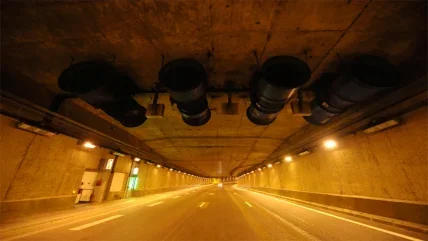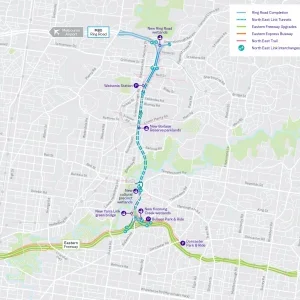
Fire safety is an integral part of tunnel ventilation design.
The ventilation system design comes about through experienced practitioners applying their engineering knowledge to each specific tunnel project. This knowledge includes modelling to understand the potential behaviour of fire, which will determine system and procedural responses.
Howden’s VentsimTM software is an enabling tool to design complete ventilation systems by developing a 3D model, but it is the testing component of the software that is key to dealing with design for potential fire risks.
SIMULATION OBJECTIVES
Fire can be a complex event to simulate accurately. For tunnels, one of the desired outcomes of a fire simulation is to predict what will happen to the ventilation circuits underground. Smoke and gases may flow within an expected route, but fire can also change some of the fundamentals of the ventilation system given the amount of heat, change of air density, and buoyancy of the hot gas that can result in quite marked changes of airflow and direction.
If the dynamics of a fire and its effect on the ventilation circuit are radically different from what is expected then the risk of exposing people to gas and smoke is substantially increased, as well as the way in which escape and rescue is designed. This is at the core of the need for fire simulation, to help designers investigate the variables and seek to minimise, or eliminate, the unexpected and achieve the best possible outcome for tunnel safety.
Fire simulation can be a great planning tool also when used in conjunction with the design of evacuation exercises. The fire simulator can enable plausible scenarios to be tested and then it can be used within actual training exercises to see how people respond, especially in realistic underground settings. In principal, a fire simulator could be used during an actual operational emergency, based on predeveloped likely simulations, where expected outcomes can support and guide emergency responders.
Development of Ventsim fire simulation
Network ventilation system fire simulators have been developed for many decades. The fire simulator in Ventsim builds on industry experience to deliver accurate insight, while also maintaining the high usability, rapid results and visual aspect that is core to the broader Ventsim design software.
Developing any model benefits from validation. In the case of fire simulation, there is a famous set of underground fire experiments based on real fires called the Waldo fire experiments, which attempted to validate some of the outcomes of what happens in fires underground.
There are three basic validations sought, temperature changes, the transport of gases and fumes and changes of airflow.
The most important part of a fire simulator is to get the temperatures coming off the fire correct, because these temperatures are what causes the air density changes and it also causes the buoyancy effects, which can result in airflow directions changing.
As we go further away from the fire, the air temperature rapidly drops, because the ground will rapidly cool any sudden change of temperature and absorb the heat from the fire very quickly. This is represented on the chart as ‘actual’. It is this zone of air temperature change that can cause a whole ventilation system in the tunnel to radically change. If this air is located somewhere where there is a vertical separation distance the buoyancy can actually result in quite significant pressures and that can push airflow into other directions that you would not normally consider.
The test using Ventsim maps very close to the actual measurements. Numerous other validations have been done to ensure accurate results as well as fast simulation speeds.
UNDERSTANDING FIRE
The actual nature of fires can be difficult to assess and so knowledge from actual incidents that have occurred or experimental data can be used within the simulator to increase understanding of outcomes.
We want to know, in particular, how hot fires will get and how quickly they release the heat during the event. All fires will start small over some time, growing until the fuel becomes exhausted and then decay and go out. It is this curve of change that we have to understand, because this is called the heat release rate and is really what drives a lot of the ventilation conditions and changes that you see during a fire.
Unfortunately, fire simulators do not actually try to simulate the fire itself. Information addressing what is going to happen to the fire needs to be inputted and then the simulators will take that information, convert it to heat and apply that heat to the ventilation model.
DEVELOPING A SIMULATION
A lot of the development of fire simulation, such as in Ventsim, is not necessarily running simulations rather it is about doing some planning first to work out what is going to happen to the different types of fires in the tunnel.
One of the first steps is to establish the fuel source for the fire. What will burn, where will the fuel come from and what type of fuels are involved. This may differ between road, rail and metro tunnels as the core fuel base comes from the vehicles within the tunnel. In the case of a road tunnel, it would be vehicles fuelled by petrol, diesel or batteries and tyres, plastics and seating. We can accumulate knowledge on the specifications associated with each vehicle type from manufacturer’s data (e.g., fuel tank capacity, tyre mass).
Once fuels are established, the data can be entered into the software to build a library of fire sources and have them available for simulation. The driving goal is to understand how fire can change ventilation systems and plan against them. Ventsim has a Dynamic Fire Simulator that gives access to some of the emergency tools and other tools for gas explosions and emergency escape as well.
Preset fire events can be selected using the library and entered into the model within any part of the tunnel. This can be moved around to understand variances, acting as a tool for training or for planning.
It could also be a tool for actual emergencies if the model was set up with these correct presets in advance.
An incident of fire is not defined with a simple start and finish. Fire will progress from its initial small state, growing and burning for some time, before decaying and ceasing. So it can be described as a series of three stages within a single event. This is matched in the Ventsim software model through the event wizard, allowing the fire to have the stages mapped out based on data entered.
Simulations can be adjusted based on changes to the fire itself as well as for other things in the ventilation system, for example, turning a fan on or off. This flexibility enhances the range of insights across the model.
When a ventilation system is modelled, the normal flow of air and gases can be noted and seen. The expectation might be that smoke from a fire will follow a similar path. However, as previously noted, fires can behave in different ways, so the value of the fire simulator is in providing that further tested insight.
One thing, in particular, to monitor is the level of carbon monoxide. The Ventsim model will produce a carbon monoxide generation estimate automatically for a fire simulation to help establish the potential risk of danger to people.
As the simulation proceeds, the fire stages can be observed graphically in colour along with the charting of carbon monoxide levels. Airflow direction can also be observed and that may indicate changed states due to heat and buoyancy or other effects taking place, requiring a response around evacuation.
Fire requires oxygen and the model will automatically alter the burn rate of the fire to match the oxygen available – and to the amount of fuel it can affect, even if there is a huge amount of fuel that could potentially be added to the fire being modelled. This results in more realistic fire behaviour. In some cases there may be an oxidising agent within the fuel source. The Ventsim software feature that automatically accounts for changes in oxygen can be turned off, therefore, to reflect that the chemical would also contribute oxygen.
Rollback occurs where you have a hot fire causing the smoke to rise to the roof of the tunnel and then to move backwards along the roof against the ventilation flow. This is effectively a bi-directional movement of air and an extremely complex scenario to model even with computational fluid dynamics (CFD); however, this effect can be simulated to an extent by applying the rollback feature to areas either side of the fire that could potentially be affected.
Useable learnings from a fire simulation
Looking to the objective of planning and design for the best outcomes, a lot of information can be learned from a simulation.
Monitors can be placed throughout the tunnel to understand air flow and gas levels at each point. This can be done along the course of the fire as it goes through the stages so we can understand the full dynamic and impact:
- How does the fire behave?
- Are the planned escape routes workable over the event?
Answers can be tested in simulations with fires of different sources placed at different locations along the tunnel model. The modelling can help to examine if the ventilation design might be adapted to negate issues identified, or as an active agent against fire impact, to increase safety and enable escape routes to be maintained for longer.
It is important for the simulation tools to integrate well into the actual system design as placement of fans, fire doors, and escape routes can all be tested out to optimise from a safety perspective. Actively altering the design means that each scenario output can be improved.
When developing escape route plans, in particular, the Ventsim software, for example, has both an Escape Route Analyzer and a Calculator to help establish the safest and most efficient pathways for exit, and the time to travel those routes.
Through this, the fire safety modelling can help to ensure that the nominated safe locations in a tunnel (e.g., refuge bays) can be reached during an incident, and how long it might take for people passing through dangerous conditions.
In the case of an actual event, the Escape Route Calculator could also help rescue teams to assess the best routes to get to a particular location, and to find routes to best avoid, where possible, dangerous levels of smoke and gas.
SUMMARY
Fire simulation can play a vital part in the development of safe ventilation systems for tunnels. By combining all the information provided by the simulation, designers and operators can gain more insight and predictable views of the dangers that need to be addressed in establishing the infrastructure and for emergency planners during operations.
Originating in the underground mining industry and extending into infrastructure tunnels, Howden’s Ventsim software has been used for many decades for ventilation design, providing users with a graphical and intuitive way of developing and testing fire safety systems. The software’s Fire Simulator, in particular, has a depth of features to fully illustrate and understand the complex impact of fire on a design leading to optimised final designs and informed emergency planning.







